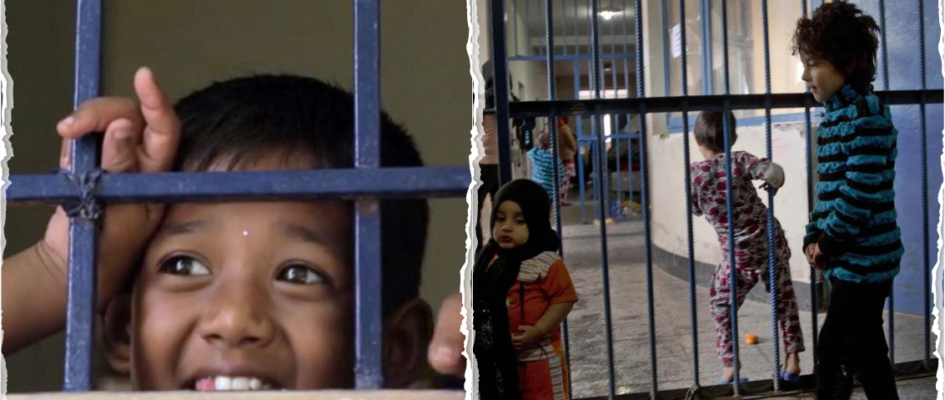Recently, the parliamentary punitive committee has made a proposal in the parliament to allow the children born in prison to stay with their mothers until the age of twelve instead of the current six years to ensure their well-being and growth. Well this will be a great step only if the children in the prison are not being deprived of the facilities and rights which they are entitled to and their stay in the prison is not prejudicing them being part of the society.
‘The current policy allows children under the age of six to remain in the prison with their mothers; children older than six, if no family member is prepared to care for them, are sent to institutions managed by the State’s Women and Child Welfare Department.’
Essentially, this asks if staying with the mother is better for the child. Children of incarcerated parents are the most vulnerable group of the society. Many times they have been disentitled to certain basic provisions because of their parent’s involvement in an offending behavior.
The latest Prison Statistics India Report 2020, states that as of December 31, 2020, there were 1,427 women prisoners with 1,628 children, among the total 20,046 women prisoners countrywide. Of this number, 1,184 women prisoners were under trial prisoners accompanied by 1,345 children and 214 convicted prisoners, who were accompanied by 246 children.
A newborn has an open mind and absorbs all they observe. The environment they are in now has the most influence on them since it forms the biggest mental impressions.
Numerous experts and psychologists assert that a child’s development is greatly influenced by their first five formative years. Prisons do not provide the most conducive environment for child development, the continued interface of the child with the criminal justice system and societal perception affects the psychological, social, emotional and the educational well-being of the child.
Due to the extreme stigma these children endure, the State must take conscious efforts and particular care to ensure that the rights of these children are realized. Since they are more vulnerable to having a negatively impacted socio-psychological development, they require more attention, emotional support, and safety.
Supreme Court in its judgment in RD Upadhyay vs. State of Andhra Pradesh and Others stated that the child of an incarcerated parent shall not be treated as a convict and care shall be taken for providing them with facilities of food, medical care, educational and recreational activities as a matter of right. Female prisoners who gave birth in the prison were to be allowed to keep the child with them till the child attains the age of six years and later on child to be put under the guardianship of a family member of the female prisoner (as per her wishes) or to be sent to suitable institutions run by the social welfare department. The SC directed the amendment in Jail manuals and relevant rules and regulations for the compliance with its direction given in the said judgment.
The above judgment was based on the special and specific provisions made in Part III and Part IV of the Constitution of India. Article 15 prohibits the discrimination on the grounds of religion, race, caste, sex or place of birth. Article 21 provides that no person shall be deprived of his life and personal liberty, except according to the procedure of established law. Article 39(f) directs the State to ensure that the children are given opportunities and facilities to develop in healthy manner and in conditions of freedom and dignity and that childhood and youth is protected against exploitation and against moral and material abandonment. All these provisions of our Constitution laid down that it is the responsibility of the state to ensure that children are not being discriminated on the basis of the place of birth even if it is a prison, it is the duty of the state to ensure that upbringing of the children is being conducted in the right environment and they are not being deprived of or exploited of their mere basic right on account of their parent’s involvement in the criminal justice system. Imprisonment and punishment in our justice system is a mode to turn these convicts into better individuals so that when they are released from the sentence they become a better individual and can be a part of the society once again. Ensuring that these offenders get to become a part of the society again, there being a past record, is not easy and is way more difficult for female prisoners with children.
Article 2 of the UN Convention on the Rights of the Child, states that children have ‘the right to not be discriminated against or punished because of anything their parent has done’. Although it is intended for judges to take into account how a parent’s prison sentence may affect their children; this is not always the case. The repercussions are disastrous, the fact that the child had no choice nor was he entitled to choose his parents gets forgotten. Children being the national asset of the country, their growth and development is going to determine the kind of future generation that will be presented to us.
According to some studies conducted, the main causes of women ending up in prison were poverty, domestic abuse, mental illness, and drug use. It suggested funding community centers to assist women who run the danger of becoming entangled in criminal activity.
According to the specialized organization Women in Prison, they have frequently been let down by state services and systems long before this point when they enter prison. It is obvious how pregnant women, mothers, and children are harmed by incarceration on an intergenerational basis.
Despite laws protecting women, it is common to see discrimination against women at different points in their lives. If a woman gets into trouble with the law or is found guilty of a crime, her problems only get worse. Compared to their male counterparts, female inmates deal with countless issues. There is no one law solution for this issue, every child is different, the circumstances of every convicted female prisoner are going to be different, it would be for the best interest for the child that the court takes these cases with great caution and does what is considered to be the best for the child. The convicted female prisoner must be consulted for her child, her preference must be taken into consideration since that will be her right as mother.
The Supreme Court of India had also stressed that these kids shouldn’t be treated as under trials or prisoners while they’re in custody alongside their mother. Such a youngster has an inalienable right to food, shelter, healthcare, clothes, education, and recreational opportunities.
It is also a duty and a right to make provisions for child delivery as well as prenatal and postnatal care for the mother and the kid.
A study conducted by TISS, Mumbai showed how the conditions of the children can be improved by involvement of various departments and social workers. It will also help to eliminate the overburden that will be created in the judiciary upon dealing with not just the female offender but also her child. The study suggested construction of a certain campus for the mother-child duo so as to ensure they have the right premises for the upbringing of the child. Incorporating these suggestions will surely help to meet the cause of the issue.
Many times referred to as “hidden victims,” these children of incarcerated parents face a variety of difficulties such as psychological strain, exclusion from school, financial difficulties, and the like. In order to ensure that these children’s rights are realized, the state legislatures have been advised by the highest court to enact the appropriate laws.
Maternal incarceration frequently has unintended and detrimental effects on children, which can affect their behavior, health, and chances for an education. Maternal incarceration has detrimental effects on both mothers and their offspring, and it is likely to have long-lasting effects that span generations. There are numerous national and international jurisdictions where small children (often under the age of five) are allowed to live in prison with their mothers.
The effects of prison environments on imprisoned mothers and their offspring who are born or raised there are much more wide that can be concluded based on some small studies. As they work to become the greatest mothers they can be and attain abstinence from crime, pregnancy and motherhood can be positive turning moments for some women who are incarcerated. It is to be ensured that the vicious cycle of crime doesn’t get repeated and both, the mother and child, have an opportunity to become part of the society as civilized individuals.
The numerous and complicated needs of pregnant women, mothers, and their young children are not sufficiently met by the policies and punishment system, which was primarily created for men, according to mothers’ experiences. The last option should be to imprison expectant mothers and moms with small children. Instead, they should receive comprehensive, specifically designed care, ideally in community settings, to address all of their interconnected needs.
Examining subjective experiences of imprisoned mothers is critical to broaden our understanding on how they can be better supported to ensure their positive pregnancy and birthing experiences. For women, becoming a mother has existential significance; nonetheless, parenthood is a complicated and meaningful experience for moms who are detained. The correctional system and policies, which were primarily built for men, are not currently equipped to accommodate the diverse and complex needs of pregnant and parenting women in prison. These women face additional logistical, mental, and physical obstacles as a result of their pregnancy and raising a small child while incarcerated. Increasing mothers’ exposure to information and support services would assist them in making the best decisions for their children given their unique situation.
Enhancing the quality of life for mothers and their children can be achieved by implementing non-custodial measures for mothers with children, assisting mothers in using age-appropriate contact techniques, and making sure that mothers have opportunities and support to engage in their parental duties independently while incarcerated.
By Vaidehee Purohit, 4th Year B.A. LL.B (Hons.), Faculty of Law, The Maharaja Sayajirao University of Baroda, Vadodara

